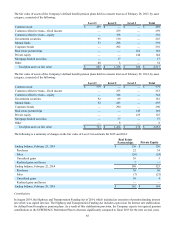Albertsons 2015 Annual Report Download - page 85
Download and view the complete annual report
Please find page 85 of the 2015 Albertsons annual report below. You can navigate through the pages in the report by either clicking on the pages listed below, or by using the keyword search tool below to find specific information within the annual report.
83
Assumptions
Weighted average assumptions used to determine benefit obligations and net periodic benefit cost consisted of the following:
2015 2014 2013
Benefit obligation assumptions:
Discount rate(1) 3.80% 4.65% 4.25%
Rate of compensation increase —% —% 2.00%
Net periodic benefit cost assumptions:(2)
Discount rate(1) 4.65 – 4.10% 4.25% 4.55%
Rate of compensation increase —% 2.00% 2.00%
Expected return on plan assets(3) 7.00 – 6.50% 7.00% 7.25%
(1) The Company reviews and selects the discount rate to be used in connection with measuring its pension and other
postretirement benefit obligations annually. In determining the discount rate, the Company uses the yield on corporate
bonds (rated AA or better) that coincides with the cash flows of the plans’ estimated benefit payouts. The model uses a
yield curve approach to discount each cash flow of the liability stream at an interest rate specifically applicable to the
timing of each respective cash flow. The model totals the present values of all cash flows and calculates the equivalent
weighted average discount rate by imputing the singular interest rate that equates the total present value with the stream of
future cash flows. This resulting weighted average discount rate is then used in evaluating the final discount rate to be used
by the Company.
(2) Net periodic benefit cost is measured using weighted average assumptions as of the beginning of each year.
(3) Expected long-term return on plan assets is estimated by utilizing forward-looking, long-term return, risk and correlation
assumptions developed and updated annually by the Company. These assumptions are weighted by the actual or target
allocation to each underlying asset class represented in the pension plan asset portfolio. The Company also assesses the
expected long-term return on plan assets assumption by comparison to long-term historical performance on an asset class
to ensure the assumption is reasonable. Long-term trends are also evaluated relative to market factors such as inflation,
interest rates, and fiscal and monetary policies in order to assess the capital market assumptions.
The Company calculates its expected return on plan assets by using the market related value of plan assets. The market related
value of plan assets is determined by adjusting the actual fair value of plan assets for unrecognized gains or losses on plan
assets. Unrecognized gains or losses represent the difference between actual returns and expected returns on plan assets for each
fiscal year and are recognized by the Company evenly over a three year period. Since the market related value of assets
recognizes gains or losses over a three year period, the future value of assets will be impacted as previously deferred gains or
losses are recognized.
For those retirees whose health plans provide for variable employer contributions, the assumed healthcare cost trend rate used
in measuring the accumulated postretirement benefit obligation before age 65 was 7.25 percent as of February 28, 2015. The
assumed healthcare cost trend rate for retirees before age 65 will decrease by 0.25 percent for each year through fiscal 2026,
until it reaches the ultimate trend rate of 4.50 percent. For those retirees whose health plans provide for variable employer
contributions, the assumed healthcare cost trend rate used in measuring the accumulated postretirement benefit obligation after
age 65 was 6.00 percent as of February 28, 2015. The assumed healthcare cost trend rate for retirees after age 65 will decrease
through fiscal 2026, until it reaches the ultimate trend rate of 4.50 percent. For those retirees whose health plans provide for a
fixed employer contribution rate, a healthcare cost trend is not applicable. The healthcare cost trend rate assumption would have
the following impact on the amounts reported: a 100 basis point increase in the trend rate would impact the Company’s service
and interest cost by less than $1 for fiscal 2015; a 100 basis point decrease in the trend rate would impact the Company’s
accumulated postretirement benefit obligation as of the end of fiscal 2015 by approximately $7; and a 100 basis point increase
would increase the Company’s accumulated postretirement benefit obligation by approximately $8.
Pension Plan Assets
Plan assets are held in a master trust and invested in separately managed accounts and other commingled investment vehicles
holding domestic and international equity securities, domestic fixed income securities and other investment classes. The
Company employs a total return approach whereby a diversified mix of asset class investments is used to maximize the long-
term return of plan assets for an acceptable level of risk. Alternative investments are also used to enhance risk-adjusted long-
term returns while improving portfolio diversification. Risk is managed through diversification across asset classes, multiple
investment manager portfolios and both general and portfolio-specific investment guidelines. Risk tolerance is established
through careful consideration of the plan liabilities, plan funded status and the Company’s financial condition. This asset
allocation policy mix is reviewed annually and actual versus target allocations are monitored regularly and rebalanced on an as-
























